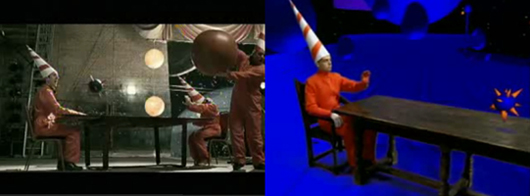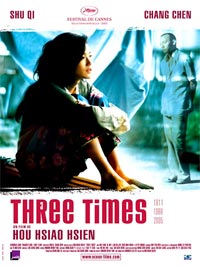In 2004, as the Matrix Ping Pong video link bounced its way from inbox to inbox, people where amused by the re-creation of a ping pong match with Matrix style special effects, using people instead of computer technology. Viewers were amazed at the elaborate costumes, only to be topped by even more amazing choregraphy. Perspective changes and camera angles are reproduced. Influences of Matrix 360 camera spinning and earlier Cantonese martial arts films are pervasive. Part of its success was the evident work and planning that was required to design and execute the scene. The idea of simulating the simulated was both ingenious and topical. However media criticism aside, it’s just a pleasure to watch.
The clip comes from a popular Japanese television show Kasou Taishou, where contestants performs skits before a panel of judges. These skits often involve re-creating camera work and special effects of film. That same year, Neil Tennant and Chris Lowe of the UK pop band Pet Shop Boys release the video for the song “Flamboyant.” In the video, a (stereo)typical Japanese corporate employee is seen struggling to design a skit for the show. Interspersed in the video are mock Japanese ads starring Tennant and Lowe. Two years later, they take the idea one step further recently their their new video, for “I’m with Stupid.” In it, Matt Lucas and David Walliamsthe stars of the British comic skit series “Little Britian” to replicate PBS videos “Go West” and “Can You Forgive Her.” The result is a bizarre re-intereption of the CGI intensive PBS videos.
When I first started on this post, I was going to try to say that these examples are a “reaction” to the increasing virtual parts of lives. However, my thinking has shifted towards this reading this phenomenon as the process of “reflection” that has a long traditional in cultural production. As our lives are becoming increasingly virtual, synthetic, and digital, our analogue lives reflect back the new digital nature of what we experience. Like a house of mirrors, people are reflecting back what they see. These mirrors, as found in the amusement parks, distort the original image, bending and stretching people’s reflection, but not beyond recognition. The participants on Kasou Taishou started copying the images from the Matrix, which itself is a reflection or new interpretation of the fight choreography of Cantonese martial arts films. Pet Shop Boys first merely replay their reflection (with splices of fake Japanese commerical staring themselves.) Things get much more interesting when Tennant and Lowe realize that the truly interesting part of the Flamboyant video was re-creating the digital with the analogue, while adding their own personal distortion through a distinctly British comedic lens.

Advances in telecommunication and media production technology have blown open the opportunity to create and share these types of cultural call and response we are witnessing. The history of parody is a prime example of this, a traditional cultural dialogue through media artifacts. I’m not all surprised, in this case, that Japan is playing a role here. In that, I have always been both fascinated and amazed by the observed way that Japanese culture seems to balance the respect of tradition with the advancement of modernity, especially with technology. Although, I realize that distance and language barriers may mask the tensions between these cultural forces. Part of the balance is achieved by taking the old and infusing it into the new rather than completely reject the old. Further, in the case of the real simulating the virtual, the diversity of modes of creation and distribution is extremely telling. Traditional roles are blurred. The one-to-many versus many-to-many broadcast models, East v. West cultural dominance, corporate v. independent media and pro/am production distinctions are being rendered meaningless. The end result is a far richer landscape of cultural production.
Category Archives: mediated_existence
love through networked screens
 This past weekend, I saw a remarkable film: “Three Times,” by Taiwanese director Hou Hsiao-hsien. It’s a triptych on love set in Taiwan in three separate periods — 1966, 1911, and 2005 — each section focusing on a young man and woman, played by the same actors. Hou does incredible things with time. Each of the episodes, in fact, is a sort of study in time, not just of a specific time in history, but in the way time moves in love relationships. The opening shots of the first episode, “A Time for Love,” announce that things will be operating in a different temporal register. Billiard balls glide across a table. You don’t yet understand the rules of the game that is being played. Characters gradually emerge and the story unfolds through strange compressions and contractions of time that comprise a weird logic of yearning.
This past weekend, I saw a remarkable film: “Three Times,” by Taiwanese director Hou Hsiao-hsien. It’s a triptych on love set in Taiwan in three separate periods — 1966, 1911, and 2005 — each section focusing on a young man and woman, played by the same actors. Hou does incredible things with time. Each of the episodes, in fact, is a sort of study in time, not just of a specific time in history, but in the way time moves in love relationships. The opening shots of the first episode, “A Time for Love,” announce that things will be operating in a different temporal register. Billiard balls glide across a table. You don’t yet understand the rules of the game that is being played. Characters gradually emerge and the story unfolds through strange compressions and contractions of time that comprise a weird logic of yearning.
This is the first of Hou’s films that I’ve seen (it’s only the second to secure an American release). I was reminded of Tarkovsky in the way Hou uses cinema to convey the movement of time, both across the eras and within individual episodes. There’s much to say about this film, and I hope to see it again to better figure out how it does what it does. The reason I bring it up here is that the third story — “A Time for Youth,” set in contemporary Taipei — contains some of the most profound and visually arresting depictions of the mediation of intimate relationships through technology that I’ve ever seen. Cell-phones and computers have been popping up in movies for some time now, usually for the purposes of exposition or for some spooky haunted technology effect, like in “The Matrix” or “The Ring.” In “Three Times,” these new modes of contact are probed more deeply.
The story involves a meeting of an epileptic lounge punk singer and an admiring photographer, while the singer’s jilted female lover lurks in the margins.  Hou weaves back and worth between intense face-to-face meetings and asynchronous electronic communication. At various times, the screen of the movie theater (the IFC in Greenwich Village) is completely filled with an extreme close-up of a cell-phone screen or a computer monitor, the text of an SMS or email message as big as billboard lettering. The pixelated Chinese characters are enormous and seem to quiver, or to be on the verge of melting. A cursor blinking at the end of an alleged suicide note typed into a computer is a dangling question of life and death, or perhaps just a sulky dramatic gesture.
Hou weaves back and worth between intense face-to-face meetings and asynchronous electronic communication. At various times, the screen of the movie theater (the IFC in Greenwich Village) is completely filled with an extreme close-up of a cell-phone screen or a computer monitor, the text of an SMS or email message as big as billboard lettering. The pixelated Chinese characters are enormous and seem to quiver, or to be on the verge of melting. A cursor blinking at the end of an alleged suicide note typed into a computer is a dangling question of life and death, or perhaps just a sulky dramatic gesture.
What’s especially interesting is that the most expressive speech in “A Time for Youth” is delivered electronically. Face-to-face meetings are more muted and indirect. There’s an eerie episode in a nightclub where the singer is performing on stage while the photographer and another man circle her with cameras, moving as close as they can without actually touching her, shooting photos point blank.
But it was the use of screens that really struck me. By filling our entire field of vision with them — you almost feel like you’re swimming in pixels — Hou conveys how tiny channels of mediated speech can carry intense, all-consuming feeling. The weird splotchiness of digital text at close range speaks of great vulnerability. Similarly, the revelation of the singer’s epilepsy is not through direct disclosure, but happens by accident when she leaves behind a card with instructions for what to do in case of a seizure, after spending the night at the photographer’s apartment. This all strikingly follows up the previous episode, “A Time for Freedom,” which is done as a silent film with all the dialogue conveyed on placards.
It’s one of those things that suddenly you viscerally understand when a great artist shows you: how these technologies spin a web of time around us, sending voices and gestures across space instantly, but also placing a veil between people when they actually share a space. In many ways, these devices bring us closer, but they also fracture our attention and further insulate us. Never are you totally apart, but seldom are you totally together.
“Three Times” is currently out in a few cities across the US and rolling out progressively through June in various independent movie houses (more info here).
